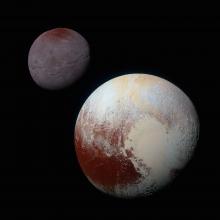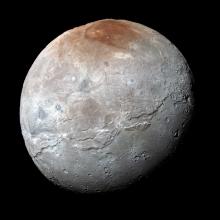Listen to today's episode of StarDate on the web the same day it airs in high-quality streaming audio without any extra ads or announcements. Choose a $8 one-month pass, or listen every day for a year for just $30.
You are here
Pluto at Opposition
Pluto shines at its best this week. It lines up opposite the Sun, so it rises near sunset and stays in view all night. It’s brightest for the year as well. Don’t bother looking for it, though; to be visible to the eye alone, it would have to shine at least a couple of thousand times brighter.
But you can spot Pluto’s location. It’s about half way between the bright planet Saturn, which is low in the east-southeast this evening, and the “teapot” outlined by the stars of Sagittarius, to Saturn’s upper right.
Pluto is hard to see because it’s tiny — only about two-thirds the size of the Moon — and because it’s a long way from the Sun — about three billion miles. Its orbit is lopsided, though. So for the next century, Pluto will move even farther from the Sun, heading for a maximum distance of 4.6 billion miles.
Pluto’s orbit was one reason the little world was dropped from the list of the Sun’s major planets. The orbit is more stretched out than any other planet’s. It’s also more tilted.
Finally, Pluto is locked in a “resonance” with Neptune, the farthest of the major planets. Pluto completes two orbits for every three made by Neptune. That suggests that Pluto is being herded along by giant Neptune — just like many other bodies in the outer solar system.
The combination spurred Pluto’s reclassification — as the Sun’s best-known dwarf planet.
Tomorrow: looking into the heart of a star.
Script by Damond Benningfield






